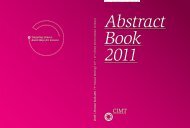Abstract Book 2010 - CIMT Annual Meeting
Abstract Book 2010 - CIMT Annual Meeting
Abstract Book 2010 - CIMT Annual Meeting
Create successful ePaper yourself
Turn your PDF publications into a flip-book with our unique Google optimized e-Paper software.
067 Hirschhaeuser | New targets & new leads<br />
Efficacy of catumaxomab in tumor spheroid killing is mediated<br />
by its trifunctional mode of action<br />
Franziska Hirschhaeuser 1 , Kirsten Dettmar 2 , Judith Atz 2 and Wolfgang Mueller-Klieser 1<br />
1 Institute of Physiology and Pathophysiology, University Medical Center of the Johannes Gutenberg-University<br />
Mainz, Germany<br />
2<br />
Fresenius Biotech GmbH, Munich, Germany<br />
112<br />
Catumaxomab is an intact trifunctional bispecific<br />
antibody targeting human EpCAM (epithelial cell<br />
adhesion molecule) and CD3 with further binding to<br />
activating Fcγ receptor type I, IIa and III. We chose<br />
multicellular tumor spheroids (MCTS) of human<br />
EpCAM-positive FaDu tumor cells in co-culture with<br />
human peripheral blood mononuclear cells as an adequate<br />
three-dimensional in vitro model for pharmacological<br />
testing of catumaxomab.<br />
Besides catumaxomab, we used the F(ab`)2 fragments<br />
of catumaxomab and the parental antibodies 26/II/6<br />
(anti-human CD3) and HO-3 (anti-human EpCAM), as<br />
well as BiLu (anti-human EpCAM x anti-mouse CD3)<br />
which is not able to bind to human T cells. We assessed<br />
the spheroid volume growth, cytokine release (IL 2, IL<br />
6, IFN γ, TNF α), and immunohistological stainings for<br />
different immune cell types and for proliferation.<br />
After 6 days, spheroids cultured with the EpCAMtargeting<br />
antibody HO-3 showed almost the same<br />
volume as control spheroids without antibody. Combination<br />
of 2.5 ng/ml HO-3 with 2.5 ng/ml 26/II/6<br />
resulted in spheroid volumes which were reduced by<br />
61%; and approaches with 5.0 ng/ml 26/II/6 showed a<br />
70% volume reduction. Catumaxomab induced a 91%<br />
decrease in spheroid volume. Comparing the effects of<br />
26/II/6 and HO-3 to catumaxomab, demonstrates less<br />
efficacy of the parental antibodies either used alone or<br />
in combination. The importance of the CD3 binding<br />
site was emphasized by further control experiments<br />
with BiLu. Similar to HO-3, BiLu showed no tumor<br />
spheroid killing. The essential function of the intact<br />
Fc region was demonstrated in control experiments<br />
using the F(ab’)2 fragment of catumaxomab: The<br />
bispecific antibody fragment lacking this functional<br />
binding site resulted in a dose-dependent volume reduction<br />
of FaDu spheroids ranging from 54-81% for<br />
concentrations of 1.0, 2.5 and 10.0 ng/ml, while catumaxomab<br />
caused a decrease of 90-100% within the<br />
same concentration range. The highest concentrations<br />
of secreted IL 2 and IFN γ were observed in the setting<br />
with tumor spheroids, PBMCs and catumaxomab.<br />
Cultures of PBMC and 5.0 ng/ml 26/II/6 yielded the<br />
highest levels for IL 6 and TNF α. In contrast, incubation<br />
with BiLu did not induce cytokine secretion,<br />
and the incubation with F(ab’)2 resulted in increased<br />
cytokine levels only for 10.0 ng/ml, but several-fold<br />
less than induced by catumaxomab. The immunological<br />
stainings showed that the infiltrating lymphocytes<br />
are mainly CD8+ T cells in spheroids treated with<br />
catumaxomab and its F(ab’)2 fragment, whereas the<br />
total amount of CD45+ cells in catumaxomab treated<br />
spheroids was higher.<br />
In summary, the results show, that all binding partners<br />
of the postulated tricell complex have to be<br />
present to exert catumaxomab’s full mode of action.<br />
These distinct effects of catumaxomab are based on<br />
the unique composition of the trifunctional bispecific<br />
antibody.<br />
Acknowledgements<br />
The technical assistance of S. Dahms-Prätorius and R. Santos is<br />
greatly acknowledged.<br />
Supported by Fresenius Biotech GmbH and TRION Pharma GmbH<br />
(Munich, Germany).



